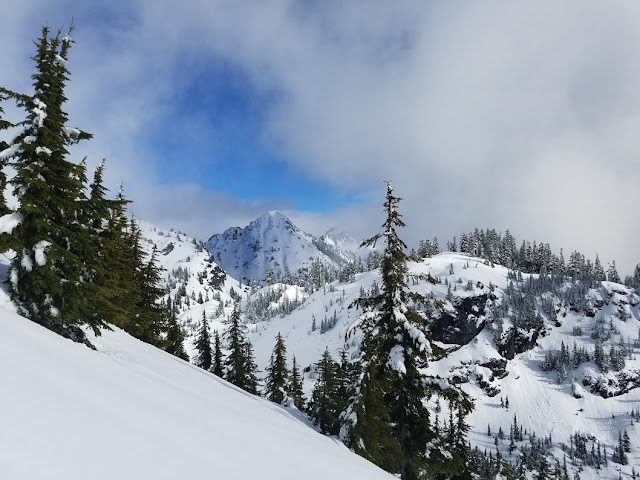On February 2nd I flew from Snoqualmie Mountain's east summit and landed on Snow Lake. I had been thinking about paragliding off Snoqualmie for a while. I've spoken to a couple other pilots who have flown off the summit to the south and landed at the Alpental ski resort in the summer, but I thought it would be better to fly around the more scenic north aspects of the mountain to land on Snow Lake to the west. This way I could also avoid a potentially dangerous (and probably illegal) landing at the ski resort during their operating hours.
 |
| Overview of my flight in Google Earth |
It was a relaxed Saturday morning and I slept in a bit. I had no real plans for the day since the weather was looking mediocre, and I'd already had a lot of hike & fly adventures the previous week. It was looking foggy outside and Tiger mountain was also completely socked in on the webcam.
However, a quick look at the Summit at Snoqualmie skiing webcams showed clear and sunny conditions at the pass. With winds from the north at just 5 mph conditions were looking excellent for my imagined flight off Snoqualmie mountain. Avalanche conditions were still low to moderate, so I felt comfortable going solo.
Excitedly I packed up my gear and had a late pancake breakfast before zipping up I-90 to the main Alpental parking lot. I starting skinning just before 11am with a goal to take off by around 3pm.
 |
| Halfway up Snoqualmie with Guye peak in the background |
The skinning was very slow low down in the trees with super icy conditions (ski crampons required) and some steep sections that I needed to boot, but once I gained enough elevation to traverse to the south ridge the traveling became much more enjoyable. I was familiar with the route as I had done it once before to ski the Slot and Crooked couloirs on Snoqualmie's north face with Lane. For a GPS track of my climb click here.
 |
| Looking south at Guye peak and the Alpental ski resort |
 |
| Views of Red Mountain to the east |
 |
| Looking up the south ridge to Snoqualmie's summit |
 |
| The only tracks on the mountain |
After summiting at 2pm I scouted out north-facing launch options, but couldn't find any areas free of trees near the ridge. I considered dropping down into the Crooked Couloir slightly, but the north-facing slopes seemed to be wind loaded quite a bit and I didn't feel like dying in an avalanche.
 |
| Looking into the Crooked Couloir from the summit ridge |
The east summit looked to be the best option with a nice rounded top and plenty of space for a northwest-facing launch. I decided to traverse south under the steep ridge instead of exposing myself to wind slabs on the north side. The south slopes were getting blasted by the sun, and I set off a couple small wet slides as I kick turned my way down the steepest sections. I wasn't concerned as the run-out was safe and the slides were easily predictable.
 |
| View of the steep ridge and east summit beyond |
 |
| The east summit of Snoqualmie |
My first couple launch attempts were aborted. At first I tried launching with the skins still on my skis (which had worked for me on my previous two ski launches), but the snow conditions were quite sticky and I wasn't able to pick up enough speed. My second launch attempt failed because I was facing too far west, and the north wind picked up one side of my wing first and flipped it over.
After some frustration and stumbling around in the snow, I finally got things figured out and had a successful cross-slope takeoff at just after 4pm. You can see a full track of my flight here. Below is a video from the flight. I also have a full flight video on my YouTube channel if you've got 10 minutes to spare.
Video highlights from the flight
The flight was incredible with nice sunset lighting as a result of my launch delays. The views looking at the Slot Couloir and steep cliffs on Snoqualmie's north side were amazing. I took advantage of the light north wind to gain some lift off the ridge as I glided to the west towards Snow Lake. It was fun to fly close to the knife-edge and have views looking over the south side into the Alpental valley. I was eyeing bailout options just in case something went wrong, but thankfully the flight went smoothly and I had plenty of altitude to make the lake landing.
After packing up my wing I had a short skin out to the divide above Snow lake, and some spicy skiing on very firm snow back out to the car -- arriving just as it got dark.
 |
| Skinning out from Snow Lake |
 |
| Skiing back out the Alpental valley (Snoqualmie mountain on the left) |
































